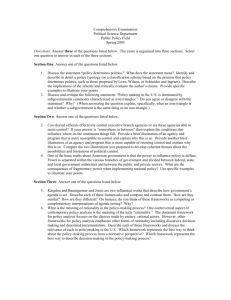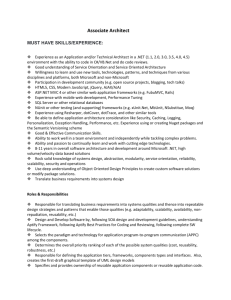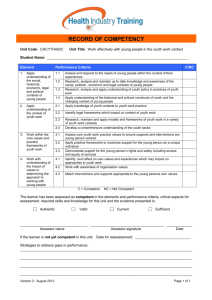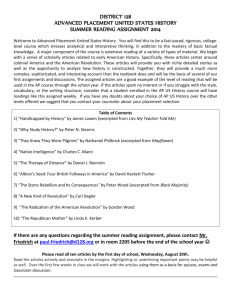in powerpoint
advertisement
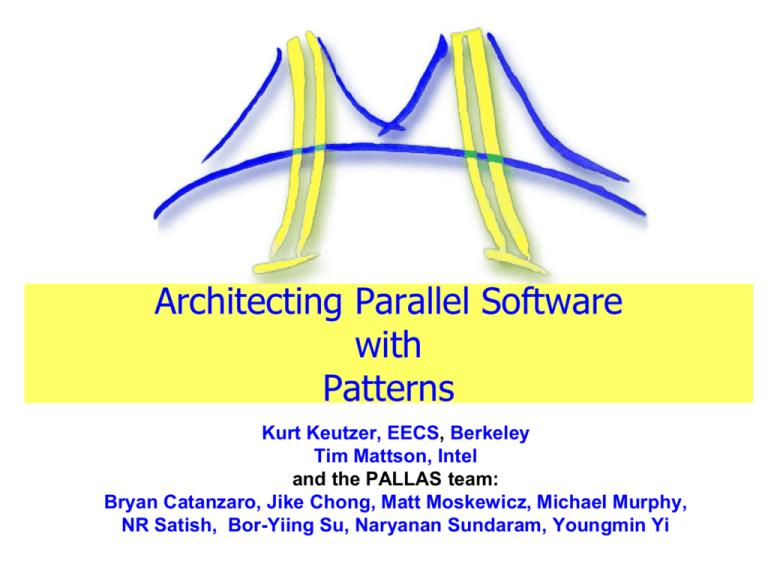
Architecting Parallel Software
with
Patterns
Kurt Keutzer, EECS, Berkeley
Tim Mattson, Intel
and the PALLAS team:
Bryan Catanzaro, Jike Chong, Matt Moskewicz, Michael Murphy,
NR Satish, Bor-Yiing Su, Naryanan Sundaram, Youngmin Yi
Executive Summary
1.
2.
3.
4.
5.
6.
Our challenge in parallelizing applications really reflects a deeper more
pervasive problem about inability to develop software in general
1. Corollary: Any highly-impactful solution to parallel programming
should have significant impact on programming as a whole
Software must be architected to achieve productivity, efficiency, and
correctness
SW architecture >> programming environments
1. >> programming languages
2. >> compilers and debuggers
3. (>>hardware architecture)
Key to architecture (software or otherwise) is design patterns and a
pattern language
The desired pattern language should span the full range of design from
application conceptualization to detailed software implementation
Resulting software design then uses a hierarchy of software
frameworks for implementation
1. Application frameworks for application (e.g. CAD) developers
2. Programming frameworks for those who build the application
frameworks
2
Outline
What doesn’t work
Common approaches to approaching parallel
programming will not work
The scope and nature of the endeavor
Challenges in parallel programming are
symptoms, not root causes
We need a full pattern language
Patterns and frameworks
Frameworks will be a (the?) primary medium
of software development for application
developers
Detail on Structural Patterns
Detail on Computational Patterns
High-level examples of composing patterns
3
Assumption #1:
How not to develop parallel code
Initial Code
Re-code with
more threads
Profiler
Performance
profile
Not fast
enough
Fast enough
Lots of failures
Ship it
N PE’s slower than 1
4
4
Steiner Tree Construction Time By
Routing Each Net in Parallel
Benchmark
Serial
2 Threads
3 Threads
4 Threads
5 Threads
6 Threads
adaptec1
1.68
1.68
1.70
1.69
1.69
1.69
newblue1
1.80
1.80
1.81
1.81
1.81
1.82
newblue2
2.60
2.60
2.62
2.62
2.62
2.61
adaptec2
1.87
1.86
1.87
1.88
1.88
1.88
adaptec3
3.32
3.33
3.34
3.34
3.34
3.34
adaptec4
3.20
3.20
3.21
3.21
3.21
3.21
adaptec5
4.91
4.90
4.92
4.92
4.92
4.92
newblue3
2.54
2.55
2.55
2.55
2.55
2.55
average
1.00
1.0011
1.0044
1.0049
1.0046
1.0046
5
Assumption #2: This won’t help either
Code in new
cool language
Re-code with
cool language
Profiler
Performance
profile
Not fast
enough
Fast enough
Ship it
After 200 parallel
languages where’s the
light at the end of the
tunnel?
6
6
Parallel Programming environments in the
90’s
ABCPL
ACE
ACT++
Active messages
Adl
Adsmith
ADDAP
AFAPI
ALWAN
AM
AMDC
AppLeS
Amoeba
ARTS
Athapascan-0b
Aurora
Automap
bb_threads
Blaze
BSP
BlockComm
C*.
"C* in C
C**
CarlOS
Cashmere
C4
CC++
Chu
Charlotte
Charm
Charm++
Cid
Cilk
CM-Fortran
Converse
Code
COOL
CORRELATE
CPS
CRL
CSP
Cthreads
CUMULVS
DAGGER
DAPPLE
Data Parallel C
DC++
DCE++
DDD
DICE.
DIPC
DOLIB
DOME
DOSMOS.
DRL
DSM-Threads
Ease .
ECO
Eiffel
Eilean
Emerald
EPL
Excalibur
Express
Falcon
Filaments
FM
FLASH
The FORCE
Fork
Fortran-M
FX
GA
GAMMA
Glenda
GLU
GUARD
HAsL.
Haskell
HPC++
JAVAR.
HORUS
HPC
IMPACT
ISIS.
JAVAR
JADE
Java RMI
javaPG
JavaSpace
JIDL
Joyce
Khoros
Karma
KOAN/Fortran-S
LAM
Lilac
Linda
JADA
WWWinda
ISETL-Linda
ParLin
Eilean
P4-Linda
Glenda
POSYBL
Objective-Linda
LiPS
Locust
Lparx
Lucid
Maisie
Manifold
Mentat
Legion
Meta Chaos
Midway
Millipede
CparPar
Mirage
MpC
MOSIX
Modula-P
Modula-2*
Multipol
MPI
MPC++
Munin
Nano-Threads
NESL
NetClasses++
Nexus
Nimrod
NOW
Objective Linda
Occam
Omega
OpenMP
Orca
OOF90
P++
P3L
p4-Linda
Pablo
PADE
PADRE
Panda
Papers
AFAPI.
Para++
Paradigm
Parafrase2
Paralation
Parallel-C++
Parallaxis
ParC
ParLib++
ParLin
Parmacs
Parti
pC
pC++
PCN
PCP:
PH
PEACE
PCU
PET
PETSc
PENNY
Phosphorus
POET.
Polaris
POOMA
POOL-T
PRESTO
P-RIO
Prospero
Proteus
QPC++
PVM
PSI
PSDM
Quake
Quark
Quick Threads
Sage++
SCANDAL
SAM
pC++
SCHEDULE
SciTL
POET
SDDA.
SHMEM
SIMPLE
Sina
SISAL.
distributed
smalltalk
SMI.
SONiC
Split-C.
SR
Sthreads
Strand.
SUIF.
Synergy
Telegrphos
SuperPascal
TCGMSG.
Threads.h++.
TreadMarks
TRAPPER
uC++
UNITY
UC
V
ViC*
Visifold V-NUS
VPE
Win32 threads
WinPar
WWWinda
XENOOPS
XPC
Zounds
ZPL
7
Assumption #3: Nor this
Initial Code
Tune
compiler
Super-compiler
Performance
profile
Not fast
enough
Fast enough
Ship it
30 years of HPC
research don’t offer
much hope
8
8
Automatic parallelization?
Basic speculative multithreading
Software value prediction
Enabling optimizations
30
Speedup %
25
20
15
10
5
v
av pr
er
ag
e
x
rte
vo
ol
f
tw
rs
er
pa
m
cf
gc
c
gz
ip
p
ga
ty
cr
af
bz
ip
2
0
Aggressive techniques
such as speculative
multithreading help,
but they are not
enough.
Ave SPECint speedup of
8% … will climb to
ave. of 15% once
their system is fully
enabled.
There are no indications
auto par. will
radically improve any
time soon.
Hence, I do not believe
Auto-par will solve
our problems.
Results for a simulated dual core platform configured as a main core and a core for
A Cost-Driven Compilation Framework for Speculative Parallelization of Sequential Programs,
speculative execution.
Zhao-Hui Du, Chu-Cheow Lim, Xiao-Feng Li, Chen Yang, Qingyu Zhao, Tin-Fook Ngai (Intel
Corporation) in PLDI 2004
9
Outline
What doesn’t work
Common approaches to parallel programming
will not work
The scope and nature of the endeavor
Challenges in parallel programming are
symptoms, not root causes
We need a full pattern language
Patterns and frameworks
Frameworks will be a (the?) primary medium
of software development for application
developers
Detail on Structural Patterns
Detail on Computational Patterns
High-level examples of composing patterns
10
Reinvention of design?
In 1418 the Santa Maria del Fiore stood without a dome.
Brunelleschi won the competition to finish the dome.
Construction of the dome without the support of flying buttresses seemed
unthinkable.
11
Innovation in architecture
After studying earlier
Roman and Greek
architecture, Brunelleschi
drew on diverse
architectural styles to arrive
at a dome design that could
stand independently
http://www.templejc.edu/dept/Art/ASmith/ARTS1304/Joe1/ZoomSlide0010.html
12
Innovation in tools
His construction of the dome design required the development of
new tools for construction, as well as an early (the first?) use of
architectural drawings (now lost).
Scaffolding for cupola
Mechanism for raising
materials
http://www.artist-biography.info/gallery/filippo_brunelleschi/67/
13
Innovation in use of building materials
His construction of the dome design also required innovative use of
building materials.
Herringbone pattern bricks
http://www.buildingstonemagazine.com/winter-06/art/dome8.jpg
14
Resulting Dome
Completed dome
http://www.duomofirenze.it/storia/cupola_
eng.htm
15
The point?
Challenges to design and build the dome of Santa Maria del
Fiore showed underlying weaknesses of architectural
understanding, tools, and use of materials
By analogy, parallelizing code should not have thrown us for
such a loop. Our difficulties in facing the challenge of
developing parallel software are a symptom of underlying
weakness is in our abilities to:
Architect software
Develop robust tools and frameworks
Re-use implementation approaches
Time for a serious rethink of all of software design
16
What I’ve learned (the hard way)
Software must be architected to achieve productivity, efficiency, and
correctness
SW architecture >> programming environments
>> programming languages
>> compilers and debuggers
(>>hardware architecture)
Discussions with superprogrammers taught me:
Give me the right program structure/architecture I can use any
programming language
Give me the wrong architecture and I’ll never get there
What I’ve learned when I had to teach this stuff at Berkeley:
Key to architecture (software or otherwise) is design patterns and a
pattern language
Resulting software design then uses a hierarchy of software frameworks
for implementation
Application frameworks for application (e.g. CAD) developers
Programming frameworks for those who build the application
frameworks
17
Outline
What doesn’t work
Common approaches to parallel programming
will not work
The scope and nature of the endeavor
Challenges in parallel programming are
symptoms, not root causes
We need a full pattern language
Patterns and frameworks
Frameworks will be a (the?) primary medium
of software development for application
developers
Detail on Structural Patterns
Detail on Computational Patterns
High-level examples of composing patterns
18
Elements of a pattern language
19
Alexander’s Pattern Language
Christopher Alexander’s approach to
(civil) architecture:
"Each pattern describes a problem
which occurs over and over again
in our environment, and then
describes the core of the solution
to that problem, in such a way that
you can use this solution a million
times over, without ever doing it
the same way twice.“ Page x, A
Pattern Language, Christopher
Alexander
Alexander’s 253 (civil) architectural
patterns range from the creation of
cities (2. distribution of towns) to
particular building problems (232. roof
cap)
A pattern language is an organized way
of tackling an architectural problem
using patterns
Main limitation:
It’s about civil not software
architecture!!!
20
Alexander’s Pattern Language (95-103)
Layout the overall arrangement of a group of buildings: the height
and number of these buildings, the entrances to the site, main
parking areas, and lines of movement through the complex.
95. Building Complex
96. Number of Stories
97. Shielded Parking
98. Circulation Realms
99. Main Building
100. Pedestrian Street
101. Building Thoroughfare
102. Family of Entrances
103. Small Parking Lots
21
Family of Entrances (102)
May be part of Circulation Realms (98).
Conflict:
When a person arrives in a complex of offices or services or
workshops, or in a group of related houses, there is a good
chance he will experience confusion unless the whole
collection is laid out before him, so that he can see the
entrance of the place where he is going.
Resolution:
Lay out the entrances to form a family. This means:
1) They form a group, are visible together, and each is
visible from all the others.
2) They are all broadly similar, for instance all porches, or
all gates in a wall, or all marked by a similar kind of
doorway.
May contain Main Entrance (110), Entrance Transition (112),
Entrance Room (130), Reception Welcomes You (149).
22
Family of Entrances
http://www.intbau.org/Images/Steele/Badran5a.jpg
23
Computational Patterns
The Dwarfs from “The Berkeley View” (Asanovic et al.)
Dwarfs form our key computational patterns
24
Patterns for Parallel Programming
• PLPP is the first attempt to
develop a complete pattern
language for parallel software
development.
• PLPP is a great model for a
pattern language for parallel
software
• PLPP mined scientific
applications that utilize a
monolithic application style
•PLPP doesn’t help us much with
horizontal composition
•Much more useful to us than:
Design Patterns: Elements of
Reusable Object-Oriented Software,
Gamma, Helm, Johnson &
Vlissides, Addison-Wesley, 1995.
25
Structural programming patterns
In order to create more
complex software it is
necessary to compose
programming patterns
For this purpose, it has been
useful to induct a set of
patterns known as
“architectural styles”
Examples:
pipe and filter
event based/event driven
layered
Agent and
repository/blackboard
process control
Model-view-controller
26
Put it all together
27
Our Pattern Language 2.0
Applications
Choose your high level
structure – what is the
structure of my
application? Guided
expansion
Pipe-and-filter
Efficiency Layer
Productivity Layer
Agent and Repository
Process Control
Event based, implicit
invocation
Choose you high level architecture? Guided decomposition
Identify the key
computational patterns –
what are my key
computations?
Guided instantiation
Task Decomposition ↔ Data Decomposition
Group Tasks
Order groups
data sharing
data access
Model-view controller
Graph Algorithms
Graphical models
Iteration
Dynamic Programming
Finite state machines
Map reduce
Dense Linear Algebra
Backtrack Branch and Bound
Layered systems
Sparse Linear Algebra
N-Body methods
Arbitrary Static Task Graph
Unstructured Grids
Circuits
Structured Grids
Spectral Methods
Refine the structure - what concurrent approach do I use? Guided re-organization
Event Based
Data Parallelism
Pipeline
Task Parallelism
Divide and Conquer
Geometric Decomposition
Discrete Event
Graph algorithms
Digital Circuits
Utilize Supporting Structures – how do I implement my concurrency? Guided mapping
Shared Queue
Master/worker
Fork/Join
Distributed Array
Shared Hash Table
Loop Parallelism
CSP
Shared Data
SPMD
BSP
Implementation methods – what are the building blocks of parallel programming? Guided implementation
Thread Creation/destruction
Message passing
Speculation
Barriers
Process Creation/destruction
Collective communication
Transactional memory
Mutex
Semaphores
28
Our Pattern Language 2.0
Applications
Choose your high level
structure – what is the
structure of my
application? Guided
expansion
Choose you high level architecture? Guided decomposition
Task Decomposition ↔ Data Decomposition
Group Tasks
Order groups
Productivity Layer
Efficiency Layer
Process Control
Event based, implicit
invocation
data sharing
data access
Dynamic Programming
Berkeley
View
Graphical models
Finitedwarfs
state machines
13
Map reduce
Dense Linear Algebra
Backtrack Branch and Bound
Layered systems
Sparse Linear Algebra
N-Body methods
Arbitrary Static Task Graph
Unstructured Grids
Circuits
Structured Grids
Spectral Methods
Garlan and Shaw Model-view controller
Pipe-and-filter
Architectural
StylesIteration
Agent and Repository
Identify the key
computational patterns –
what are my key
computations?
Guided instantiation
Graph Algorithms
Refine the structure - what concurrent approach do I use? Guided re-organization
Event Based
Data Parallelism
Pipeline
Task Parallelism
Divide and Conquer
Geometric Decomposition
Discrete Event
Graph algorithms
Digital Circuits
Utilize Supporting Structures – how do I implement my concurrency? Guided mapping
Shared Queue
Master/worker
Fork/Join
Distributed Array
Shared Hash Table
Loop Parallelism
CSP
Shared Data
SPMD
BSP
Implementation methods – what are the building blocks of parallel programming? Guided implementation
Thread Creation/destruction
Message passing
Speculation
Barriers
Process Creation/destruction
Collective communication
Transactional memory
Mutex
Semaphores
29
Outline
What doesn’t work
Common approaches to parallel programming
will not work
The scope and nature of the endeavor
Challenges in parallel programming are
symptoms, not root causes
We need a full pattern language
Patterns and frameworks
Frameworks will be a (the?) primary medium
of software development for application
developers
Detail on Structural Patterns
Detail on Computational Patterns
High-level examples of composing patterns
30
Assumption #4
Louis Pasteur
Inventor of Pasteurization
The future of
parallel
programming is
not training Joe
Coder to learn to
write parallel
programs
The future of parallel
programming is getting
domain experts to use
parallel application
frameworks (without
them ever knowing it)
31
People, Patterns, and Frameworks
Design Patterns
Application Developer
Uses application
design patterns
(e.g. feature extraction)
to architect the
application
Application-Framework Uses programming
Developer
design patterns
(e.g. Map/Reduce)
to architect the
application framework
Frameworks
Uses application
frameworks
(e.g. CBIR)
to develop application
Uses programming
frameworks
(e.g MapReduce)
to develop the
application framework
32
Patterns and Frameworks
Patterns
Application
Patterns
Programming
Patterns
Computation &
Communication
Patterns
Developer
Target
application
Frameworks
Application
Framework
Application
Framework
Developer
Programming
Framework
Developer
Programming
Framework
Computation &
Communication
Framework
Framework
Developer
Today’s talk focuses only
on the middle of the
pattern language
HW target
Application
SW Infrastructure
Pattern Language
End User
Platform
Hardware Architect
33
Example: Content-Based
Image Retrieval Application
Large number of untagged
photos
Want quick retrieval based on
image query
34
34
Patterns
Feature Extraction
& Classifier
Application
Patterns
Map Reduce
Programming
Pattern
Barrier/Reduction
Computation &
Communication
Patterns
Cellphone User
Personal Search
Face Search
Developer
Application
Framework
Developer
Map Reduce
Programming
Framework
Developer
CUDA
Framework
Developer
Hardware Architect
Frameworks
CBIR Application
Framework
Map Reduce
Programming
Framework
CUDA
Computation &
Communication
Framework
GeForce 8800
Application
SW Infrastructure
Pattern Language
Example:
CBIR Layers
Platform
Eventually
1
2
3
Domain Experts
+
Domain literate programming +
gurus (1% of the population).
Application
patterns &
frameworks
End-user,
application
programs
Parallel
patterns &
programming
frameworks
Application
frameworks
Parallel programming gurus (1-10% of programmers)
Parallel
programming
frameworks
The hope is for Domain Experts to create parallel code with little or no understanding
of parallel programming.
Leave hardcore “bare metal” efficiency layer programming to the parallel
programming experts
36
Today
1
2
3
Domain Experts
+
Domain literate programming +
gurus (1% of the population).
Application
patterns &
frameworks
End-user,
application
programs
Parallel
patterns &
programming
frameworks
Application
frameworks
Parallel programming gurus (1-10% of programmers)
Parallel
programming
frameworks
• For the foreseeable future, domain experts, application framework builders, and
parallel programming gurus will all need to learn the entire stack.
• That’s why you all need to be here today!
37
Definitions - 1
Design Patterns: “Each design pattern describes a problem
which occurs over and over again in our environment, and then
describes the core of the solution to that problem, in such a way
that you can use this solution a million times over, without ever
doing it the same way twice.“ Page x, A Pattern Language,
Christopher Alexander
Structural patterns: design patterns that provide solutions to
problems associated with the development of program structure
Computational patterns: design patterns that provide solutions
to recurrent computational problems
38
Definitions - 2
Library: The software implementation of a computational pattern
(e.g. BLAS) or a particular sub-problem (e.g. matrix multiply)
Software architecture: A composition of structural and
compositional patterns
Framework: An extensible software environment (e.g. Ruby on
Rails) organized around a software architecture (e.g. modelview-controller) that allows for programmer customization only
in harmony with the software architecture
Domain specific language: A programming language (e.g.
Matlab) that provides language constructs that particularly
support a particular application domain. The language may also
supply library support for common computations in that domain
(e.g. BLAS). If the language is restricted to maintain fidelity to a
one or more structural patterns and provides library support for
common computations then it encompasses a framework (e.g.
NPClick).
39
Architecting Parallel Software
Decompose Tasks
Decompose Data
•Group tasks
•Identify data sharing
•Order Tasks
•Identify data access
Identify the Software
Structure
Identify the Key
Computations
40
Identify the SW Structure
Structural Patterns
•Pipe-and-Filter
•Agent-and-Repository
•Event-based coordination
•Iterator
•MapReduce
•Process Control
•Layered Systems
These define the structure of our software but they do not
describe what is computed
41
Analogy: Layout of Factory Plant
42
Identify Key Computations
Computational
Patterns
Computational patterns describe the key computations but not how
they are implemented
43
Analogy: Machinery of the Factory
44
Architecting Parallel Software
Decompose Tasks/Data
Order tasks
Identify Data Sharing and Access
Identify the Software
Structure
•Pipe-and-Filter
•Agent-and-Repository
•Event-based
•Bulk Synchronous
•MapReduce
•Layered Systems
•Arbitrary Task Graphs
Identify the Key
Computations
• Graph Algorithms
• Dynamic programming
• Dense/Spare Linear Algebra
• (Un)Structured Grids
• Graphical Models
• Finite State Machines
• Backtrack Branch-and-Bound
• N-Body Methods
• Circuits
• Spectral Methods
45
Analogy: Architected Factory
Raises appropriate issues like scheduling, latency, throughput,
workflow, resource management, capacity etc.
46
Outline
What doesn’t work
Common approaches to parallel programming
will not work
The scope and nature of the endeavor
Challenges in parallel programming are
symptoms, not root causes
We need a full pattern language
Patterns and frameworks
Frameworks will be a (the?) primary medium
of software development for application
developers
Detail on Structural Patterns
Detail on Computational Patterns
High-level examples of composing patterns
47
Logic Optimization
Architecting Parallel Software
Decompose Tasks
•Group tasks
•Order Tasks
Decompose Data
• Data sharing
• Data access
Identify the Key Computations
Identify the Software Structure
49
Structure of Logic Optimization
netlist
Scan
Netlist
Build
Data
model
Highest level structure is the
pipe-and-filter pattern
•(just because it’s obvious doesn’t
mean it’s not worth stating!)
Optimize
circuit
netlist
50
Structure of optimization
timing
optimization
area
optimization
Circuit
representation
power
optimization
Agent and repository : Blackboard structural pattern
Key elements:
Blackboard: repository of the resulting creation that is shared by all agents
(circuit database)
Agents: intelligent agents that will act on blackboard (optimizations)
Controller: orchestrates agents access to the blackboard and creation of the
aggregate results (scheduler)
51
Timing Optimization
While (! user_timing_constraint_met &&
power_in_budget){
restructure_circuit(netlist);
remap_gates(netlist);
resize_gates(netlist);
retime_gates(netlist);
….
more optimizations …
….
}
52
Structure of Timing Optimization
Local
netlist
user
timing
constraints
Timing
transformati
ons
controller
Process control
structural pattern
53
Architecture of Logic Optimization
Group, order tasks
Decompose
Data
Group, order tasks
Group, order tasks
Graph algorithm pattern
Graph algorithm pattern
54
Parallelism in Logic Synthesis
Logic synthesis offers lots of easy coarse-grain parallelism:
Run n scripts/recipes and choose the best
For per-instance parallelism: General program structure offers
modest amounts amount of parallelism:
We can pipeline (pipe-and-filter) scanning, parsing,
database/datamodel building
We can decouple agents (e.g. power and timing) acting on the
repository
We can decouple sensor (e.g. timing analysis) and actuator (e.g.
timing optimization)
We can use programming patterns like graph traversal and
branch-and-bound
But how do we keep 128 processors busy?
55
Here’s a hint …
56
Key to Parallelizing Logic Optimization?
We must exploit the data parallelism inherent in a graph/netlist
with >2,000,000 cells
Partition graphs/netlists into highly/completely independent
modules
Even modest amount of synchronization (e.g. stitching together
overlapped regions) will devastate performance due to
Amdahl’s law
Data Parallelism in Respository
timing
timing
Optimization 1 Optimization 2
timing
Optimization 3
……..
timing
optimization 128
Circuit
Database
Repository manager must partition underlying circuit to allow
many agents (timing, power, area optimizers) to operation on
different partitions simultaneously
Chips with >2M cells easily enable opportunities for manycore
parallelism
58
Moral of the story
•
•
•
•
Architecting an application doesn’t automatically make it
parallel
Architecting an application brings to light where the parallelism
most likely resides
Humans must still analyze the architecture to identify
opportunities for parallelism
However, significantly more parallelism is identified in this way
than if we worked bottom-up to identify local parallelism
59
Today’s take away
Many approaches to parallelizing software are not working
Profile and improve
Swap in a new parallel programming language
Rely on a super parallelizing compiler
My own experience has shown that a sound software architecture is the greatest
single indicator of a software project’s success.
Software must be architected to achieve productivity, efficiency, and correctness
SW architecture >> programming environments
>> programming languages
>> compilers and debuggers
(>>hardware architecture)
If we had understood how to architect sequential software, then parallelizing
software would not have been such a challenge
Key to architecture (software or otherwise) is design patterns and a pattern
language
At the highest level our pattern language has:
Eight structural patterns
Thirteen computational patterns
Yes, we really believe arbitrarily complex parallel software can built just from these!
60
More examples
61
Architecting Speech Recognition
Pipe-and-filter
Recognition
Network
Graphical
Model
Inference Engine
Active State
Computation Steps
Pipe-and-filter
Dynamic
Programming
MapReduce
Voice
Input
Beam
Search
Iterations
Signal
Processing
Most
Likely
Word
Sequence
Iterator
Large Vocabulary Continuous Speech Recognition Poster: Chong, Yi
Work also to appear at Emerging Applications for Manycore Architecture
62
CBIR Application Framework
New Images
Choose Examples
Feature Extraction
Train Classifier
Exercise Classifier
Results
User Feedback
?
?
Catanzaro, Sundaram, Keutzer, “Fast SVM Training and Classification on
Graphics Processors”, ICML 2008
63
Feature Extraction
Image histograms are common to many feature extraction procedures,
and are an important feature in their own right
• Agent and Repository: Each agent
computes a local transform of the
image, plus a local histogram.
• Results are combined in the
repository, which contains the global
histogram
The data dependent access patterns found when constructing
histograms make them a natural fit for the agent and repository
pattern
64
Train Classifier:
SVM Training
Update
Optimality
Conditions
iterate
Train Classifier
MapReduce
Select
Working
Set,
Solve QP
Gap not small
enough?
Iterator
65
Exercise Classifier : SVM
Classification
Test Data
SV
Compute
dot
products
Dense Linear
Algebra
Exercise Classifier
Compute
Kernel values,
sum & scale
MapReduce
Output
66
Key Elements of Kurt’s SW Education
AT&T Bell Laboratories: CAD researcher and programmer
Algorithms: D. Johnson, R. Tarjan
Programming Pearls: S C Johnson, K. Thompson, (Jon Bentley)
Developed useful software tools:
Plaid: programmable logic aid: used for developing 100’s of
FPGA-based HW systems
CONES/DAGON: used for designing >30 application-specific
integrated circuits
Synopsys: researcher CTO (25 products, ~15 million lines of code,
$750M annual revenue, top 20 SW companies)
Super programming: J-C Madre, Richard Rudell, Steve Tjiang
Software architecture: Randy Allen, Albert Wang
High-level Invariants: Randy Allen, Albert Wang
Berkeley: teaching software engineering and Par Lab
Took the time to reflect on what I had learned:
Architectural styles: Garlan and Shaw
Design patterns: Gamma et al (aka Gang of Four), Mattson’s PLPP
A Pattern Language: Alexander, Mattson
Dwarfs: Par Lab Team
67

